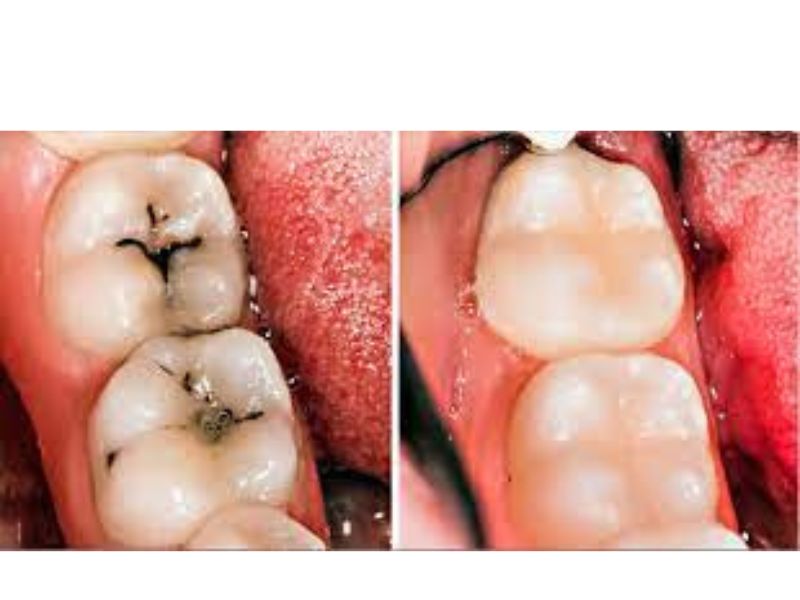We include products we think are useful for our readers. If you buy through links on this page, we may earn a small commission. Here’s our process.
What causes cavities?
Dental cavities, or caries, are tiny holes in the hard surface of the teeth. They are caused by bacteria on the surface of teeth creating acid out of sugar. The most common culprit is a bacterium known as Streptococcus mutans.
The bacteria form a sticky film known as plaque. The acids in plaque remove minerals from (demineralize) your enamel — a coating of the teeth made mostly of calcium and phosphate. This erosion causes tiny holes in the enamel. Once the acid damage spreads into the dentin layer underneath the enamel, a cavity forms.
Getting rid of cavities at home
Many home treatments are based off of a study from the 1930s that suggested that cavities are caused by lack of vitamin D in the diet. In this study, kids who added vitamin D to their diets showed a reduction in cavities. However, those who added vitamin D while also removing grain products from their diets had the best results. This is possibly because grains can stick to the teeth.
Not getting enough vitamin D may make teeth more susceptible to cavities, but we now understand that this is only a part of the puzzle. Other risk factors for cavities include:
- dry mouth or having a medical condition that reduces the amount of saliva in the mouth
- eating foods that cling to teeth, like candy and sticky foods
- frequent snacking on sugary foods or drinks, like soda, cereals, and ice cream
- heartburn (due to acid)
- inadequate cleaning of teeth
- bedtime infant feeding
Once a cavity has penetrated the dentin, you won’t be able to get rid of it at home. The following home remedies might help prevent cavities or treat “pre-cavities” by remineralizing weakened areas of your enamel before a cavity develops:
- Sugar-free gum
Chewing sugar-free gum after meals has been shown in clinical trials to help remineralize enamel. Gum containing xylitol has been researched extensively for its ability to stimulate saliva flow, raise the pH of plaque, and reduce S. mutans, but long-term studies are needed.
Sugar-free gum containing a compound called casein phosphopeptide-amorphous calcium phosphate (CPP-ACP) has been shown to reduce S. mutans even more than xylitol-containing chewing gum. You can find this type of gum in stores.
- Vitamin D
Vitamin D is important to help absorb calcium and phosphate from the food you eat. Studies show an inverse relationship between eating foods high in vitamin D and calcium, like yogurt, and cavities in young children. You can get vitamin D from dairy products, like milk and yogurt. You can also get vitamin D from the sun.
More recent research has challenged how vitamin D can affect dental health.
- Brush with fluoride toothpaste
Fluoride plays an important role in preventing cavities and remineralizing enamel. Extensive research has been done to show that regularly brushing your teeth with a fluoride toothpaste prevents cavities.
Most studies have been conducted either in children or adolescents, so more research is needed in adults and the elderly.
- Cut out sugary foods
This is the cavity remedy that no one likes to hear — stop eating so much sugar. The World Health Organization says that eating sugar is the most important risk factor for cavities. They recommend reducing your sugar intake to less than 10 percent of your total caloric intake for the day.
If you’re going to eat sugar, try not to snack on sugary foods throughout the day. Once the sugar is gone, your enamel has a chance to remineralize. But if you are constantly eating sugar, your teeth don’t get the chance to remineralize.
- Oil pulling
Oil pulling is an ancient practice that involves swishing around an oil, like sesame or coconut, in your mouth for about 20 minutes, then spitting it out. Claims that oil pulling “removes toxins” from the body aren’t backed up by evidence. But a small, triple-blind, placebo-controlled clinical trial showed that oil pulling with sesame oil reduces plaque, gingivitis, and the number of bacteria in the mouth just as effectively as chlorhexidine mouthwash. Larger studies are needed to confirm these effects.
- Licorice root
Extracts from the Chinese licorice plant (Glycyrrhizauralensis) can combat the bacteria responsible for dental cavities, according to at least one study.
One researcher has taken this to the next level and created a licorice lollipop to help fight tooth decay. Pilot studies using licorice extract in a lollipop showed they were effective in significantly reducing S. mutans in the mouth and preventing cavities. Larger and more long-term studies are needed.
Source: www.healthline.com









